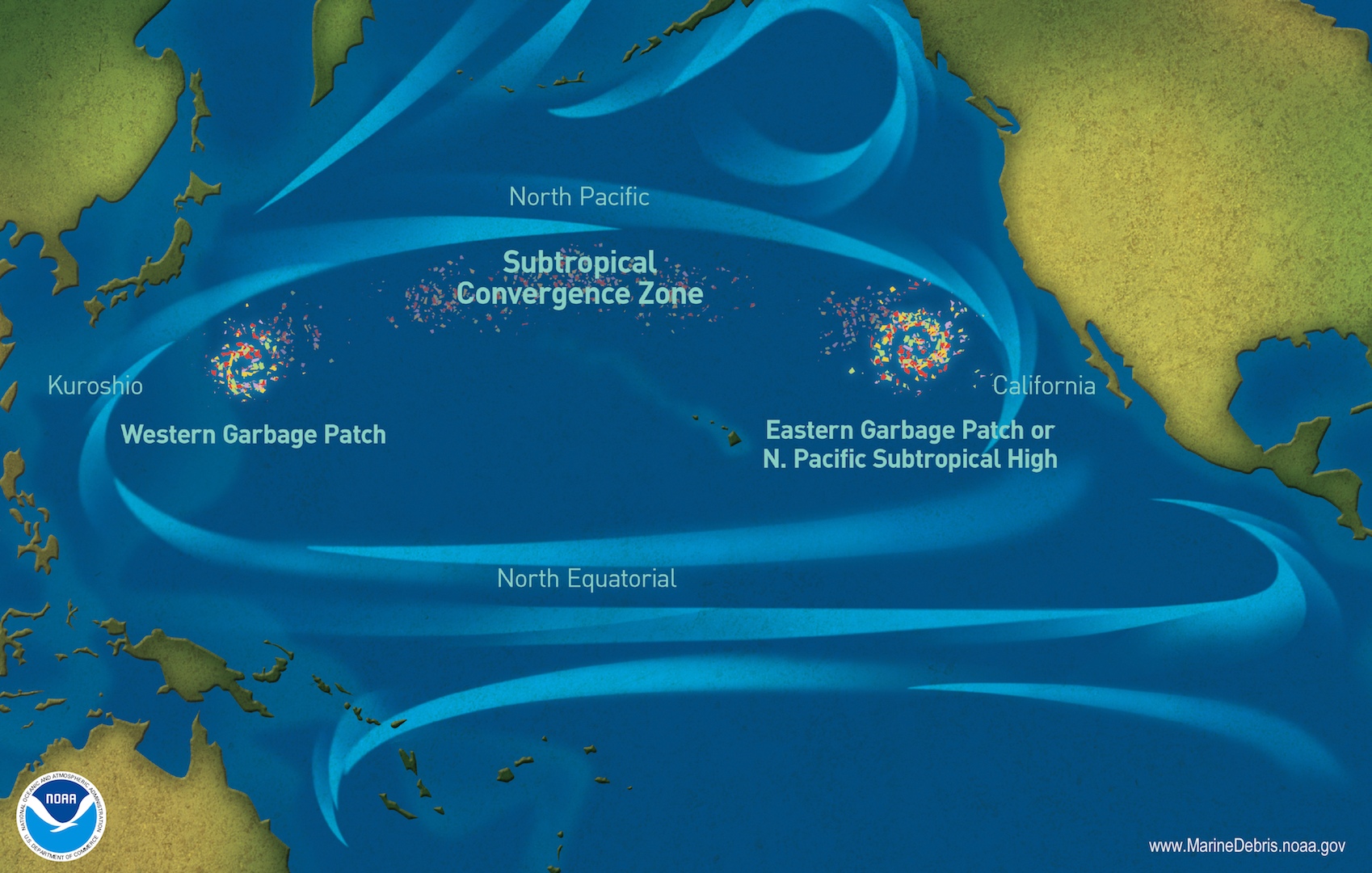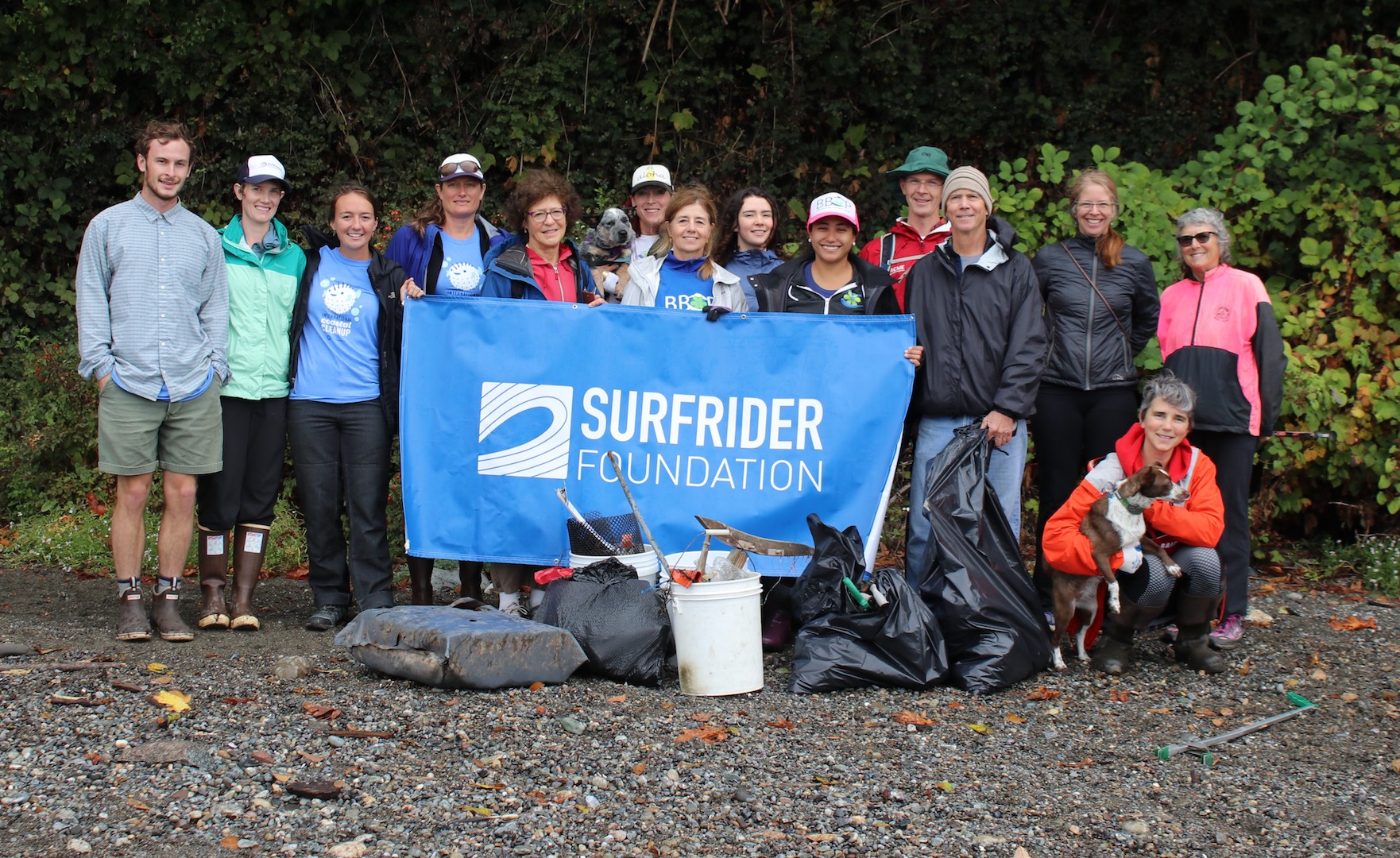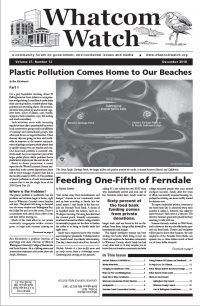by Ron Kleinknecht
Part 1
On a gray September morning, about 50 Bellinghamsters from infants to octogenarians trudged along Locust Beach under leaky skies carrying buckets, reusable plastic bags, grabbers and recording charts. All nonnatural items were picked up and recorded: cigarette butts, pieces of plastic, cans, bottles, wrappers, food containers, rope, fish netting and much miscellany.
Such activities occur with increasing regularity these days, spearheaded by several local conservation groups and local affiliates of national and international groups, that often join forces on targeted beaches. These cleanup days are going on here and worldwide in response to the massive encroachment of garbage and particularly plastic that is rapidly taking over our beaches and seas. Our local trash problem is currently relatively small, but is an important part of the larger global plastic debris problem that is predicted to triple in just the next decade. (1)
Based on future projections, a recent report by the World Economic Forum estimates that, at the current disposal rate, there will be more tonnage of plastic than fish in the world’s oceans by 2050. (2) The problem of plastic pollution is of such monumental concern that it was the single focus of the 2018 Earth Day. (3)
Where Is the Problem?
The plastic problem is worldwide, but the problem and solution begin at home, right here in Whatcom County’s rivers, beaches and bays. The plastic left along or dumped into the water washes into Bellingham Bay, the Salish Sea and on to the ocean. There it accumulates with debris from other rivers and bays before moving on.
Much of the trash afloat in our oceans eventually congregates within oceanic gyres, or large scale currents creating an enormous vortex like that shown above in the Pacific Ocean. (4) An ocean gyre is a system of circulating ocean currents formed by the Earth’s wind patterns and the forces created by the rotation of the planet. The centers of these gyres are areas of calm where the material accumulates. There are five such garbage patches around the globe, but the Pacific patch remains the largest.
The garbage patches, largely of plastics (polyethylene and polypropylene), have accumulated over the past 50 to 60 years, and they continue to grow at an alarming rate. The Great Pacific Garbage Patch (GPGP) acquires its garbage mostly from land sources in Asia and North America (80 percent). Rivers then transport the garbage to the Pacific Ocean where it is picked up by circulating currents into the gyre. (5)
The remaining 20 percent comes from fishing vessels, offshore rigs and large cargo ships that dump their trash intentionally or lose it during storms. The major part of the ocean-sourced debris mass, about 46 percent, is in the form of megaplastics and derelict fishing nets, also referred to as “ghost nets,” lost from ocean trawlers. It is further estimated that 10-20 percent of the current Pacific patch is from the Japanese tsunami of 2011. (5) A recent study estimated that the GPGP contains approximately 1.8 trillion plastic particles. (5)
The Pacific gyre is the largest of the five for the simple reason that the world’s largest contributors are in eastern Asia, where one half of the world’s plastic is produced. (6) The single largest contributing country by far is China (85 percent) followed by other Asian countries. Although the United States is also among the top polluters, we are quite a ways down the list at 20. (7)
What is a Gyre?
A gyre is a large system of rotating ocean currents. Wind, tides, and differences in temperature and salinity drive ocean currents. The ocean churns up different types of currents, such as eddies, whirlpools, or deep ocean currents. Larger, sustained currents — the Gulf Stream, for example — go by proper names. Taken together, these larger and more permanent currents make up the systems of currents known as gyres.
There are five major gyres: the North and South Pacific Subtropical Gyres, the North and South Atlantic Subtropical Gyres, and the Indian Ocean Subtropical Gyre.In some instances, the term “gyre” is used to refer to the collections of plastic waste and other debris found in higher concentrations in certain parts of the ocean.
While this use of “gyre” is increasingly common, the term traditionally refers simply to large, rotating ocean currents.
From NOAA: https://oceanservice.noaa.gov/facts/gyre.html.
How Big Is the Problem?
There are many sources of this problem, but here I’ll just consider a few examples locally and globally. Most readers will likely have some familiarity with these items in their homes.
Among the largest contributors to the plastic pollution problem is the single-use plastic shopping bag (now banned in Bellingham). The sheer number of these bags produced and used is staggering. It is estimated that shoppers, worldwide, use 500 billion per year. (6)
Plastic used in food packaging is right up there and, for the most part, it too is single use. We tear the package open, extract the food and throw the plastic away.
Yet another major polluter with which we are familiar is the plastic beverage bottle. The Container Recycling Institute estimates that, in 2014, 100.7 billion plastic beverage bottles were sold in the United States. And this number is highly likely to be increasing. (8)
A few other major contributors among the top 10 internationally are plastic takeout items such as styrofoam food containers, cups, straws and eating utensils, food and candy wrappers, beverage containers and plastic caps. You can probably add to this list from your own experience. (9)
To make matters worse, 85 percent of plastic worldwide is not recycled, and, even if the users put these items in the recycle bin, much of it will still end up in a landfill. (8)
And these are only the plastics that we can see.
Microplastics
Some plastic products degrade and break up into smaller pieces when exposed to sunlight, whereas others simply erode. In neither case do they just disappear. Rather, they all break down into smaller units of plastic. Those degraded particles less than 5 mm (.2 in.), about the size of a grain of rice, are referred to as microplastic. (10)
Microplastics cannot always be seen by the naked eye. Even satellite imagery doesn’t show them. The microplastics of the Great Pacific Garbage Patch can simply make the water look like a cloudy soup. This microplastic soup is intermixed with larger macroplastic items, such as bags and fishing nets.
Microplastics make up a large portion of the plastic pollution problem, worldwide and locally. Much of the plastic washed into the sea remains afloat, such as in the garbage patch, but a significant amount becomes microplastics that sink to the bottom or wash up on beaches, where they are not readily observable.
A University of Washington oceanography student recently conducted her senior thesis looking at such microplastics on 12 Puget Sound beaches. These 12 samples contained an average of 1,776 pieces of microplastics per 3-foot-square sampling plot. (11)

The Great Pacific Garbage Patch, the largest of five such patches around the world, is located between Hawaii and California.
Clothing Fibers, Food Sources
A second major source of water-polluting microplastics are microfibers that make their way into the environment from shedding of synthetic fiber material from fleece jackets and other polyester fiber clothing during washing. These fibers are too small to be caught by filters in washing machines and wastewater treatment plants. They are washed directly into sewers, through treatment facilities and into our bays and oceans, and much washes onto our beaches. To my knowledge, no one has tested our local beaches for these and other microplastics. But since they are found elsewhere in Puget Sound, there is reason to believe that they are here as well. They are even found in Arctic waters.
Patagonia, an outdoor gear manufacturer that uses a great deal of this synthetic material in its clothing lines, has participated in studies to learn more about their products and are working to develop fabrics that release fewer such particles. An interesting finding of these studies was that top-loading washing machines produced seven times as many fibers as did front-loading machines. (12 )
Few people today are immune to the reach of microplastic particles. For example, a recent study tested bottled water from 259 bottles from 11 different brands, purchased in 19 locations in 9 countries. They found 93 percent of the bottles showed some sign of microplastic contamination, largely polypropylene. Where the plastic originated is not clear, but it is likely that some came from the packaging or the bottling process itself. (13)
Another study found after sampling water taps on five continents, an average of 83 percent showed plastic fiber content. Across several sample sites in the United States, 94 percent of the taps contained plastic, including the EPA offices. (14) In Germany, in a study of 24 beer brands tested, each contained plastics. It is literally in the air we breathe and in what we eat and drink. We seem unable to escape the reach or microplastics.
So, we have plastic bags and bottles floating in the seas, and fibers washing out of our fleece jackets and vests, and we find these tiny things in our water and beaches and bottled and tap water and in our beer.
Marine Organisms
Since much of this plastic pollution ends up in the water, we should start by looking at its effects on marine organisms. Macro and microplastics that are suspended in our oceans, streams and rivers affect most living organisms from the bottom of the food web to the top.
Zooplankton, which are tiny critters that drift throughout our water systems, form the base of the food web that sustains many marine animals. These tiny creatures consume microplastics, which, in turn, when eaten by larger critters such as fish, shell fish, and even whales, are passed on up the food web. For example, studies have shown that bivalves such as oysters, clams and mussels exposed to microplastics (which most are), tend to accumulate them in their digestive organs. These microplastics in turn can cause .deficiencies in the oysters’ reproductive processes. (15)
Here you can see a video of zooplankton eating pieces of plastic .
It is not just plastic particles that are at issue. Toxic and hazardous chemicals such as PVCs found in water readily attach to microplastics. When plastic is consumed by marine organisms, they also ingest the toxins and are subject to possible effects of both plastics and the toxins they carry. For example, an experiment demonstrated that fish exposed to plastics that had absorbed toxic pollutants in a lab developed liver toxicity to a significantly greater extent than control fish exposed only to the plastic. It is of note that both groups had some liver pathology. (16)
Another marine critter a little higher on the food chain is the polychaete, a many legged marine worm found nearly everywhere marine. They are one of the most common marine organisms on earth. They ingest microplastics from the mud and sand and they in turn become food for crabs, fish and wading birds, among other animals. A recent study examined 10 polychaetes over three days and found that they excreted a total of 1,306 pieces of styrofoam. (17) Further, these microplastics take longer to move through the digestive system of the worms, leading to their slower growth, which in turn provides less food for the predators that depend on them.
Nearly 700 marine species have been observed to have direct contact with plastics debris while microplastics have been found directly in at least 114 species so far. (18,19)
In addition to fish, seabirds are affected, such as albatrosses mistaking microplastics for fish eggs and feeding them to their young. These young birds then inadvertently can die from starvation with a belly full of plastic. One million seabirds per year are thought to die from one or another type of plastic exposure. (20)
Ghost Nets
Macroplastics are a hazard to sea life as well. Marine mammals and other creatures are becoming entangled and drowning in nets and lines — an event known as “ghost fishing,” with the ghost nets. In addition to sea creatures ingesting plastics, 100,000 a year are found to have died from plastic entanglement. (21)
Recently, a female adult Steller sea lion off Vancouver Island was freed by personnel from the Vancouver, B.C. aquarium from a piece of braided plastic that was cutting into her neck and would eventually be lethal. (22) Similarly, in Thailand, a recently deceased whale that was unable to eat was found to have 80 plastic bags in its stomach. (23)
It is now believed there are 5.25 trillion pieces of plastic debris in the ocean. Of that mass, 269,000 tons float on the surface, while some four billion plastic microfibers per square kilometer litter the deep sea. (1) It is nearly impossible for aquatic animals of any size to avoid plastic exposure.
There is solid evidence that marine animals ingest plastic particles and that ingesting these plastics can harm sea creatures from the microscopic to whales. Liver damage, reduced fertility, starvation and entanglement are all well documented.
And, as noted, humans in turn consume many of these sea creatures, and thus are exposed at some levels to the plastic particles as well as any contaminants in the plastic.
Hazardous to Humans?
Given that micro and macroplastics are found in many lower animals and that this exposure can cause them harm, it seems possible that humans too could suffer adverse health effects from plastics. We do have many exposures to plastic through direct consumption from ingesting bottled water, drinking from plastic cups and straws, eating food from plastic wrapping, and consuming fish and shellfish with micro plastic particles in them. If these exposures are indeed harmful to humans, this would be a huge worldwide health problem.
However, health-related research in humans is just beginning, and little significance has been found. It seems that plastics ingested by lower animals remain largely in their digestive tracts and do not move into the muscle fibers (which is what we normally eat). An exception would involve shellfish, where it is common to eat the whole organism, digestive tract and all.
We do know, however, from a recent study that microplastics are found in humans’ digestive tracts. Stool samples taken from participants across a wide number of countries revealed microplastic particles in these participants — and having plastics in one’s stool was not limited to those who ate shellfish. The health significance of this finding is unknown, but, given this information, additional studies are underway to examine possible human health consequences of these microplastics, as well as even smaller nanoplastics. (23)
Thus, we know that plastics are accumulating rapidly in our oceans and on land, and that both micro and macroplastics are detrimental to many sea animals. This is reason enough to be concerned about effects of the plastic itself, as well as it being a carrier of toxic chemicals.
We all have, at some point, dropped a piece of plastic where it became litter on a beach, in a street or near a river. That piece alone probably did little to cause this plastic problem. However, when billions of others do the same thing, it adds up to an enormous global problem. Each of the estimated 5.25 trillion pieces of plastic debris in the oceans has at some point passed through or been directed by human hands. (8)
Next Month: Part 2
The focus will be on the plastic problems — what is being done globally and locally to curb this mounting pollution threat. Although there is a great deal that needs to be done, it is somewhat reassuring that a great deal is being done in terms of remediation, clean up and prevention. Clean up alone, however, cannot solve this problem if the plastic pipeline to the ocean is not stopped.
References
1. https://www.bbc.com/news/science-environment-43477233
2. https://www.aljazeera.com/news/2016/01/oceans-plastic-fish-2050-report-160120051728640.html
3. https://www.earthday.org/campaigns/plastics/plastics-campaign/
5. https://www.nationalgeographic.org/encyclopedia/great-pacific-garbage-patch/
6. https://www.nature.com/articles/s41598-018-22939-w
7. https://news.nationalgeographic.com/2018/05/plastics-facts-infographics-ocean-pollution/
8. https://www.earthday.org/2018/04/06/top-20-countries-ranked-by-mass-of-mismanaged-plastic-waste/
9. https://assignmentbro.com/blog/plastic-pollution-facts-and-statistics
10. https://oceanservice.noaa.gov/facts/microplastics.html
12. https://pubs.acs.org/doi/abs/10.1021/acs.est.6b03045
13. http://news.bbc.co.uk/2/shared/bsp/hi/pdfs/14_03_13_finalbottled.pdf
14. https://orbmedia.org/stories/Invisibles_plastics
15. http://www.pnas.org/content/113/9/2430
16. https://rochmanlab.files.wordpress.com/2016/08/rochman-et-al-2013-scientific-reports.pdf
17. https://nhm.org/site/research-collections/polychaetous-annelids/faqs
18. https://www.sciencedirect.com/science/article/pii/S0964569115000897
20. https://assignmentbro.com/blog/plastic-pollution-facts-and-statistics
22. https://www.cbc.ca/news/canada/british-columbia/sea-lion-rescue-vancouver-aquarium-1.4585359
23. https://www.bbc.com/news/world-asia-44344468
24. https://www.nytimes.com/2018/10/22/health/microplastics-human-stool.html
___________________________________
Ron Kleinknecht is professor emeritus of psychology and dean emeritus of Western Washington University’s College of Humanities and Social Sciences. He is a lifelong nature and conservation enthusiast who writes about the Pacific Northwest.





























